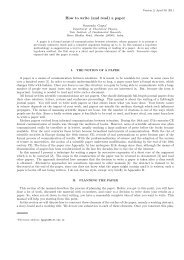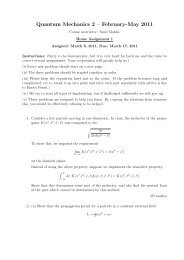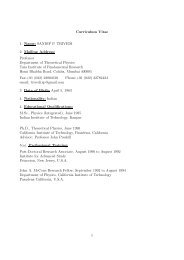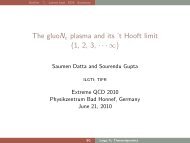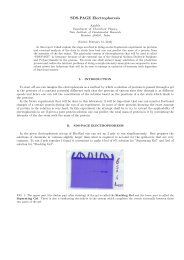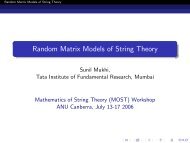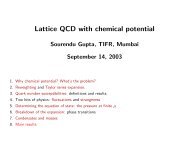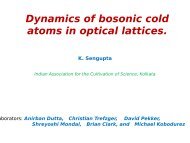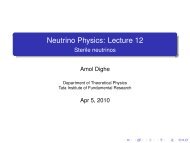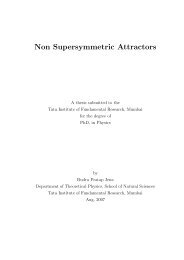Hot Stuff - Department of Theoretical Physics - Tata Institute of ...
Hot Stuff - Department of Theoretical Physics - Tata Institute of ...
Hot Stuff - Department of Theoretical Physics - Tata Institute of ...
Create successful ePaper yourself
Turn your PDF publications into a flip-book with our unique Google optimized e-Paper software.
PHYSICS NEWS<br />
<strong>of</strong> these quantities is limited only by<br />
the accuracy <strong>of</strong> your instruments.<br />
However, if the sample size was<br />
smaller, say about 10 6 molecules,<br />
then there would be intrinsic<br />
physical limits on the accuracy.<br />
Repeating accurate measurements<br />
would not give the same value,<br />
but would reveal thermodynamic<br />
fluctuations. The study <strong>of</strong> these<br />
fluctuations about a hundred years<br />
ago revealed that new physical<br />
information hides here. For example,<br />
the fluctuations <strong>of</strong> energy <strong>of</strong> such a<br />
sample are Gaussian and the width<br />
is related to the specific heat <strong>of</strong> the<br />
material.<br />
S σ<br />
σ 2<br />
κ<br />
T (MeV)<br />
79 140 160<br />
165 166<br />
µ (MeV)<br />
B<br />
720 420 210 54 20 10<br />
(A)<br />
2 m 1<br />
Exp. Data Lattice QCD<br />
HRG<br />
1.5<br />
1<br />
0.5<br />
0<br />
(B)<br />
2<br />
1<br />
0<br />
-1<br />
m 2<br />
-2<br />
4 5 6 10 20 30 100 200<br />
s NN (GeV)<br />
Figure 2: A comparison <strong>of</strong> the<br />
predictions <strong>of</strong> QCD with experimental<br />
determination <strong>of</strong> the shape <strong>of</strong><br />
the spectrum <strong>of</strong> thermodynamic<br />
fluctuations in the excess <strong>of</strong> baryons<br />
over antibaryons in heavy-ion collisions<br />
[7]. The experimental data comes from<br />
an international collaboration called<br />
STAR working with a collider in the<br />
Brookhaven Laboratory near New York.<br />
The lattice predictions come from the<br />
Mumbai chapter <strong>of</strong> the ILGTI.<br />
This looks like a cumbersome way <strong>of</strong><br />
finding the specific heat, but what if<br />
it were so hard to make the material<br />
that there was no way to produce<br />
enough to do a macroscopic<br />
measurement <strong>of</strong> the specific heat?<br />
Then thermodynamic fluctuations<br />
may be the only way to relate<br />
mesoscopic physics (here <strong>of</strong> around<br />
10 6 molecules) to microscopic physics<br />
(the interactions <strong>of</strong> the molecules<br />
(3) (2)<br />
/χ<br />
T χ<br />
(4) (2)<br />
/χ<br />
χ<br />
2<br />
T<br />
which can be used to compute the<br />
specific heat). Quark matter turns<br />
out to be like this. Quark matter is<br />
produced in the lab in little bangs,<br />
creating fireballs which expand and<br />
cool. We see only the end result <strong>of</strong><br />
these collisions. By looking at the<br />
relative number <strong>of</strong> hadrons which<br />
are produced in these bangs, one can<br />
find the temperature and chemical<br />
potential just before the hadrons<br />
leave the fireball. This method is<br />
analogous to the application <strong>of</strong> the<br />
Saha equations to the Fraunh<strong>of</strong>er<br />
spectra <strong>of</strong> stars to find their surface<br />
temperatures. Knowing T and<br />
μ one should be able to predict<br />
thermodynamic fluctuations in the<br />
fireball.<br />
If this were to be possible then it<br />
must also be true that when one<br />
selects a sample <strong>of</strong> fireballs with<br />
a fixed T and μ the distribution <strong>of</strong><br />
a conserved quantity should be<br />
Gaussian. One such quantity is the<br />
excess <strong>of</strong> baryons over antibaryons.<br />
When this is measured in one<br />
little bang after another, it turns<br />
out to be approximately Gaussian<br />
distributed. The deviations from a<br />
Gaussian are as interesting as the<br />
width <strong>of</strong> the Gaussian. It turns out<br />
that the Madhava-Maclaurin series<br />
coefficients which we compute are<br />
precisely the quantities needed<br />
to predict the shape <strong>of</strong> these<br />
distributions. Our computations<br />
were checked against experimental<br />
data and found to agree very well<br />
(see Figure 2). This was a major<br />
milestone since this was the first<br />
time that lattice QCD predictions<br />
could be compared to experimental<br />
data on hot matter.<br />
6 Implications<br />
Lattice QCD has a very small number<br />
<strong>of</strong> free parameters: the QCD distance<br />
scale at which the strong interactions<br />
become weak, and the quark masses.<br />
Once all the free parameters are<br />
fixed everything else is a prediction.<br />
Typically the free parameters<br />
are fixed by matching them to<br />
experimentally determined hadron<br />
masses, as shown in Figure 1.<br />
In fact, exactly this was done in<br />
the comparison shown in Figure 2.<br />
The values <strong>of</strong> T and μ are required<br />
to make a connection between the<br />
experiment and prediction. For<br />
the experimental data these are<br />
determined as explained earlier.<br />
For the lattice QCD prediction the<br />
lattice computation directly gives the<br />
dimensionless ratio T/T c<br />
, where T c<br />
is<br />
a conventional scale <strong>of</strong> temperature<br />
called the QCD crossover<br />
temperature. At temperatures below<br />
T c<br />
strongly interacting matter has a<br />
simple hadronic description; above<br />
T c<br />
it has a simple description in<br />
terms <strong>of</strong> quarks and gluons. Lattice<br />
computations also have predictions<br />
for T c<br />
/m where m is a hadron mass.<br />
As a result, using computations such<br />
as those shown in Figure 1 one can<br />
fix T and μ for the lattice computation<br />
and make the comparison shown in<br />
Figure 2.<br />
However, one need not perform<br />
this very round-about comparison.<br />
Given the data on fluctuations,<br />
one may as well vary the single<br />
parameter T c<br />
and check whether the<br />
data is well described by the lattice<br />
QCD predictions. This was done in a<br />
unique collaboration <strong>of</strong> theorists and<br />
experimentalists with the result that<br />
an excellent fit to the data is obtained<br />
with T c<br />
= 175 +1 −7 MeV.<br />
In more familiar units, T c<br />
is<br />
about 2 trillion K. This result is a<br />
breakthrough because it is the first<br />
time that such a basic parameter<br />
<strong>of</strong> hot primordial matter has<br />
been obtained from experiments.<br />
Interestingly, this is also the highest<br />
measured temperature ever to come<br />
out <strong>of</strong> a terrestrial experiment. It is<br />
high enough to melt atomic nuclei<br />
into its constituents, the quarks.<br />
Apart from this, it is also an<br />
intellectual breakthrough since it<br />
closes a circle <strong>of</strong> reasoning which<br />
3<br />
Madhava <strong>of</strong> Sangamgrama was a member <strong>of</strong> the 13th century school <strong>of</strong> mathematics in Kerala and is supposed to have developed<br />
the method which was discovered independently several centuries later by Maclaurin. Madhava discovered the method and applied<br />
it to the computation <strong>of</strong> the tangent <strong>of</strong> any angle.<br />
4






